Welcome! I’ve worked hard to create what I think is the best speaker Ohms calculator on the internet for you.
My speaker Ohms calculator will let you:
- Find the total speaker Ohms for almost any series, parallel, or series-parallel speaker wiring.
- Find the total power your amp or stereo will output (or warn you when it can’t produce that amount of power).
- See the power supplied to each speaker for your wiring configuration.
- Find out if your speaker setup could cause amp or stereo damage before you try it out.
Note: Javascript must be enabled in your browser to see or use the tool.
Contents
SPEAKER OHMS CALCULATOR
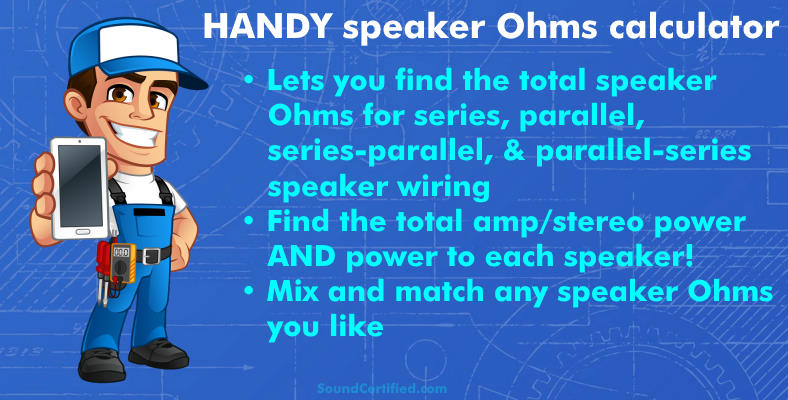
HOW TO USE THE SPEAKER OHMS CALCULATOR
Choose your speaker configuration/wiring:
- Series connected speakers
- Parallel connected speakers
- Series-parallel speakers: up to 4 “strings” of 1-4 series speakers, all series strings in parallel. (*Using 1 speaker in each string will effectively be the same as the Parallel speaker option)
- Parallel-series: up to 4 speakers in parallel which are then in series with 1 or more speakers.
Input your speaker Ohms and power values:
- Speaker impedance (Ohms): Fill in the speaker Ohms value for as many or as few speakers as you’d like.
- OPTIONALAmp/stereo power & min. Ohms rating: Input the amplifier or stereo’s power (RMS or continuous) power rating and the min. specified speaker Ohms. This will allow the calculator to determine power to each speaker in any configuration.
You can use whole numbers (2, 5, etc.) or decimal values (6.3Ω, etc.) for Ohms as needed. If using the power option, use the RMS or continuous power rating in whole Watts for your amplifier or stereo. “Peak” or “maximum” ratings are misleading and will give the wrong results.
The speaker Ohms calculator will output:
- Total speaker Ohms: This is the total speaker load the amp or radio will see based on the speaker Ohms you’ve entered.
- [Optional] Total power draw from the amp or stereo: This shows the total amount of power the calculated speaker Ohms load will draw from the amp or stereo.
- NOTE! If the total speaker load would draw excess current (exceed the power rating you specified), this means an unsafe condition would happen and you’ll see “–” to indicate an error/invalid power amount.
- [Series-parallel option] String (“Strx“) ohms: The series Ohms value for each string of speakers, 1 to 4 speakers each.
- Power to each speaker (“Sx“): Power, in Watts, each speaker will receive.
How to calculate series, parallel, or series-parallel speaker Ohms (DIAGRAM and examples)

Figuring out the total Ohms speaker load for nearly any wiring configuration isn’t as hard as it may seem. As you can see from my diagram above, there are 3 main ways to do this:
- Find the total series speaker Ohms.
- Find the total parallel speaker Ohms.
- Using a combination of #1 & #2 for more complicated speaker systems.
1. How to find the total series speaker Ohms value
These are the simplest to deal with. To find the total speaker resistance (impedance) for series speakers, simply add them all together.
For example, let’s say we have 3 speakers we’d like to use: two 8 ohm and one 16 ohm.
We’d just add these together like so: 8Ω + 8 234 + 16Ω = 32Ω
When speakers are connected in series, they share the same electrical current. The amplifier, radio, or stereo’s power will be divided among them. Note that if the total speaker load is higher than the maximum power output Ohms rating for your amp or stereo, the total power you can get will be lower.
(I’ll go into more detail about this in another section below)
2. How to calculate the total Ohms load for parallel speakers.
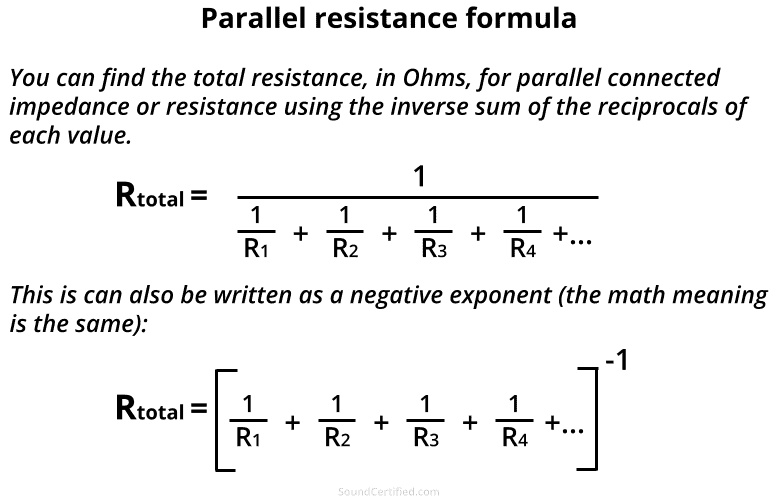
When it come to finding the total speaker impedance for parallel wiring, there are two ways to do this:
- If the speaker Ohm ratings are all the same, you can just divide by the number of speakers used.
- For parallel speakers of the same or different values, you can use the universal parallel speaker formula below. You can call this the “inverse sum of the reciprocals”, which just means we add up all the inverse (1/x) values then take one final inverse function to get the result. (I’ll explain how to do this.)
Example #1: Let’s say we have three 4 ohms speakers wired in parallel. We can use simple division to find the total speaker load:
Rparallel = 4Ω/3 = 1.33Ω
Example #2: In this example, we have four speakers of different values: two 8 ohm and two 16 ohm speakers, all wired in parallel. What is the total speaker load?
Rparallel = 1/(1/8 + 1/8 + 1/16 + 1/16)
= 1/(.125 + .125 + .0625 + .0625)
= 1/(0.375) = 2.67Ω
3. Series-parallel and other wiring types
For anything other than just series or parallel speaker wiring, we can just break it down into a few of same calculations and then add them all together.
Example #3: We have four “strings” of four 8 ohm speakers each. All four series strings are wired in parallel. We can solve this pretty easily!
(a.) Finding the series speaker Ohms: each string of four speakers is 8Ω + 8Ω + 8Ω + 8Ω or 8Ω x 4. This is 32Ω total for each series string.
(b.) Find the total parallel speaker Ohms: we have four strings, so this is 1/(1/32 + 1/32 + 1/32 1/32) or just 32Ω/4 since they’re all the same value.
So the total is 32Ω [each series string] / 4 strings = 8Ω total in series-parallel
How to find parallel speaker ohms (inverse sum of reciprocals) on a calculator
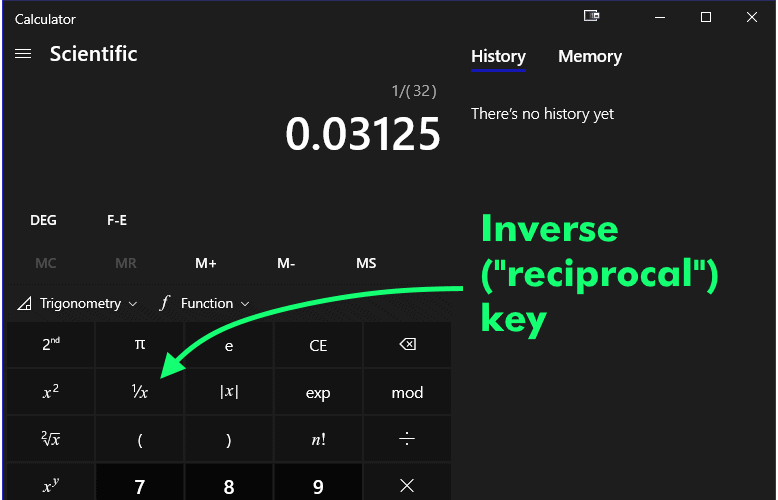
Many calculators (especially scientific ones, although that’s not a requirement) have an inverse function.
An inverse key (inverse function, or reciprocal function) is simply dividing one by some number. Having a button handy makes it much faster and less likely you’ll make a mistake, too.
Let’s take example #2 from earlier to show how you can easily find any parallel speaker load using a calculator. I’ll show where I’m using the buttons you’d use on a real calculator.
(Example #2: We have four speakers of different values: two 8 ohm and two 16 ohm speakers, all wired in parallel.)
(a.) You would enter on your calculator:
8 1/x + 8 1/x + 32 1/x + 32 1/x
which will give 0.125 + 0.125 + 0.0625 + 0.0625 = 0.375
(b.) Then we’ll take the reciprocal (inverse) of this to get our result:
0.375 1/x = 2.67 Ω (rounded from 2.66666… as we don’t need that much precision).
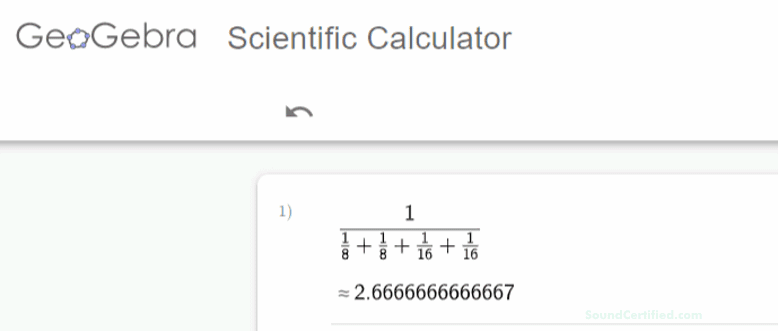
You might find it helpful to use a scientific “pretty print” calculator as they display the math you’re entering just like you’d write it on paper. This helps you be sure of what you’re entering as you go.
Amplifier power vs the speaker Ohms load
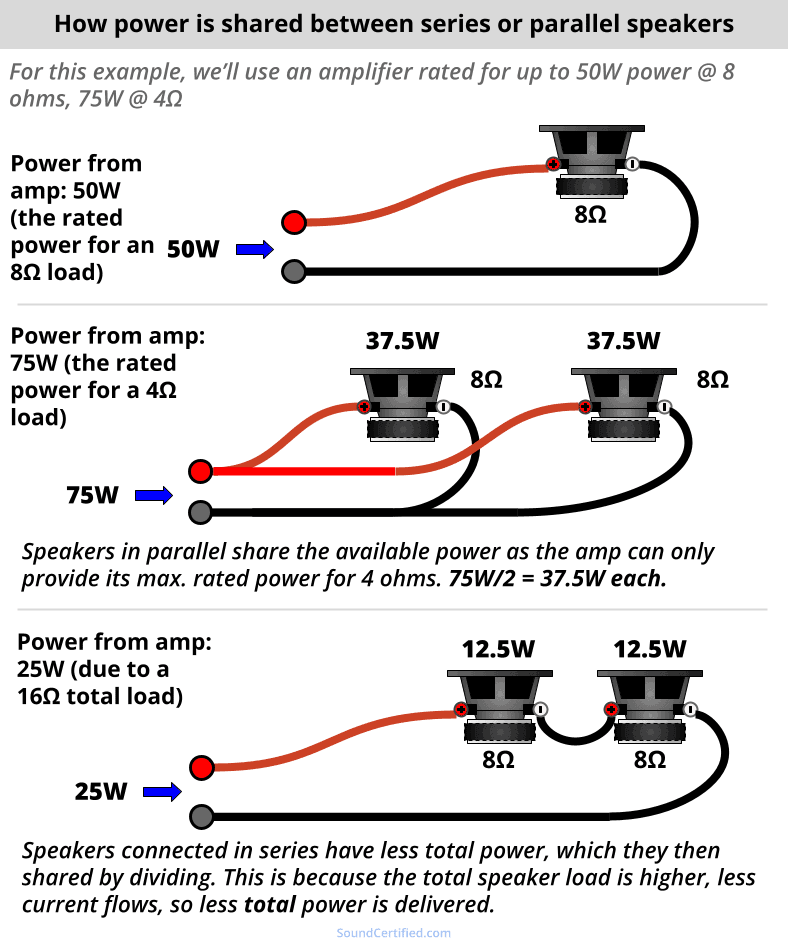
The total speaker load you end up with can have a very big impact on the power you can use. That’s because home or car stereos, amplifiers, and radios can only produce up to a certain output voltage to deliver power to speakers. If the speaker load (Ohm value) is higher, they can’t deliver as much electrical current, resulting in a lower total power provided.
How to calculate amp and speaker power for different speaker loads
Example #1: How to estimate total amplifier power at different speaker Ohm loads
For example, let’s use an example of a guitar amplifier that can provide 50 watts RMS continuous per channel into a min. of 8 ohms. As power is related to voltage and resistance, we can rearrange the formula for power to help us:
(a.) Power (P) = (Voltage (V))^2 / Resistance (R)
We can rearrange this to find voltage: Voltage (V) = square root(Power x R)
(b.) Doing a little bit of math, that means the output voltage at full power into an 8 ohm speaker would be:
V = square root(50 x 8) = √(400) = 20V(Max. output)
What happens if we connect two 8Ω woofers in series? How much power can we expect?
This would be (20V)^2 / 16Ω = 400/16 = 25 Watts
This makes sense! After all, the electrical current decreases as the resistance increases. Therefore, the amp can’t deliver as much power at 16Ω as it can at its 8Ω specification. There’s nothing wrong with using a higher impedance speaker load, but you’ll have to live with the compromise and less overall power.
Example #2: Estimating power to each speaker vs the total power delivered
Using example #1 above, we have 25W delivered in total to our 16Ω speaker load. For speakers in series, you can find the power each speaker will get even if they have different Ohm ratings.
In this case, we can use: Pspeaker = Ptotal (total power) x Speaker1/(Speaker1 + Speaker2)
This gives us: P1 (power to speaker one) = 25W*8/(16) = 25W*0.5 = 12.5W
So each speaker will receive 12.5W in this case which is 1/4 of what a single 8 ohm speaker would receive for this amplifier.
What speaker Ohm load should I use for the best power?
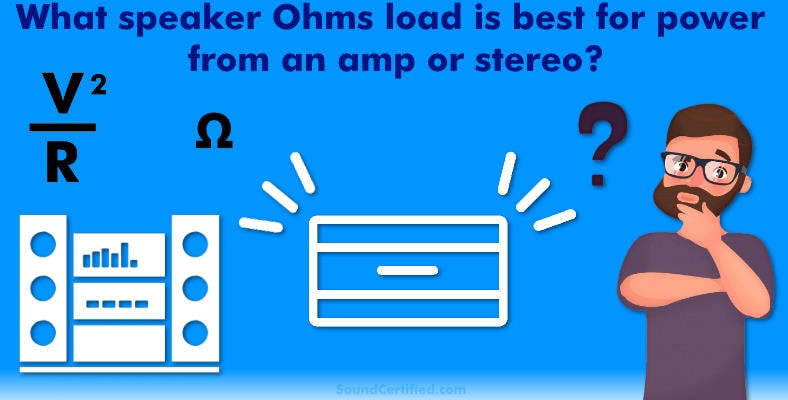
When using multiple speakers the best Ohms load for power is the lowest acceptable total speaker load the stereo or amplifier is rated to handle at maximum power output.
This is because many amplifiers (and some radios and stereos etc.) have their maximum power output possible at the minimum Ohms rating specification. This is sometimes called the Ohm rating they are “stable to.”
For example, a 2Ω stable car subwoofer amplifier may be rated like this:
- 250W x 1 @ 4 ohms
- 500 W x 1 @ 2 ohms
The specifications tell us:
- This amplifier is designed to handle as low as 2 ohms minimum
- It will produce maximum power output (maximum current) safely at a total speaker load of 2 ohms
This means to get all the power we paid for, we’ll ideally have a total speaker load that adds up to 2Ω. The problem is that when using multiple speakers it can be difficult to get match the min. speaker Ohm rating.
You’ll have to match at least the min. acceptable Ohms rating specified. Too low of a rating (say 1Ω in this case) and the amplifier can shut off, overheat, or suffer permanent damage.
Using dual voice coil speakers may help as they offer multiple speaker ohms configurations. However, it’s very common (especially if you’ve already bought speakers) to not be able to get the “perfect” total speaker Ohms load.
You’ll have to live with some compromises which may mean less total power available.
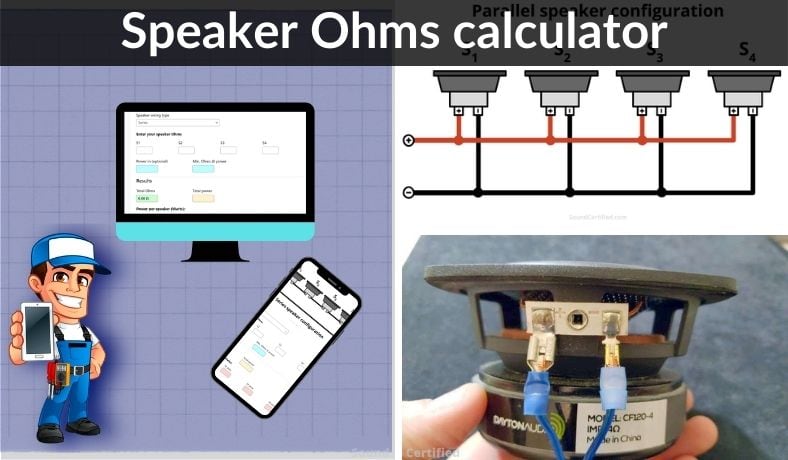

Hello Marty
Quick question : when there are crossovers along the way to the speakers, shouldn’t their impedance also be taken into account by the calculator? Or is it that it’s very small and can be neglected?
Hi, it depends on the type of crossover. For example, with a 2-way crossover, normally the impedance is the same across all frequencies, since the speaker load seen by an amp/stereo is decided by the crossover. It also depends on what you’re wanting to calculate fr figure out.
If the tweeters have a simple capacitor high-pass crossover, it will appear as an open circuit when measured with an Ohm meter, so you have to watch out for that. If you know the tweeter impedance then you can figure out what you need to know.
If you have a woofer with no crossover and a tweeter with a high-pass, the total Ohms load will be close to the woofer & tweeter in parallel when far above the cutoff frequency, but only the woofer’s impedance below the cutoff frequency. Generally a tweeter + crososver & woofer combo like that is safe enough for speaker outputs as long as the Ohms rating of each speaker meet the min. Ohms rating required.
Hi Marty
My case is the latter : a woofer in parallel with a midrange tweeter, and a simple high pass capacitor ahead of the tweeter. Both the woofer and the tweeter have an impedance of 4 Ohms.
Using the calculator got me concerned because I was finding an Req of 2 Ohms, while my amp output is 4 Ohms.
So to make it short and basic, I would be at risk if there was no capacitor before the tweeter, but the presence of the capacitor mitigates that?
Hi Marty, I’m about to build a pair of open baffle speakers.
Each one will have an
8″ full range driver of 8 ohms
a 18″ full range driver at 8 ohms
& a 15″ sub woofer with dual 8 ohm voice coils.
Preferably I would like to run these off my Valve Amplifier which is capable of running at 4 & 8 ohm. Approximately 35/w per chanel rms.
I can wire the speakers in any combo of series or parallel. How would I best achieve this ?
I have the option of bi amping ( my original thinking of how to easily setup of these speakers )
Using my Valve amp with both 8″ & 18″ in parallel for a 4 ohm load & then my Luxman SS amp for the subs which has two 8 ohm only outputs for main & remote speakers. So one 8 ohm voice coil load on each output. Can you suggest a wiring combo that would allow me to use just the one amplifier ? I did think about the 2 x 8 ohm drivers in series then parallel them with the 2 x 8 ohm woofer voice coils in series. Theoretically giving me roughly an
8 ohm load. Does this seem feasible?
Thanks Al
Hi Alan. I am a little bit unclear on the setup you’re ultimately after. For example, do you plan to use all of these speakers for full-range sound as opposed to a 2-way system?
Yes, definitely if you wire everything in series-parallel for 8 Ohms total that would work (8+8Ω in parallel with 8+8Ω). The power will be divided between all speakers evenly: 35W/4 = about 8.75W to each speaker.
The drawback that comes to mind is the 15″ subwoofer in series without a crossover means not having it used at its best for bass. But if that’s ok with you then yes wiring them like that would work fine for getting it working.
Best regards
Hi, Marty!
I’m building a custom cabinet with two Celestion Redbacks and one Pulse 15 all at 8ohms. I was intending to use a Peavey 6505+ rated at 120W RMS to play guitar through it. How should I wire the speakers, and will this setup damage my amp? Thanks in advance, and let me know if you need more info!
Hello, Chris Unfortunately, when using an odd number of speakers, you’ll have to live with compromises, but it can be done. As long as the total Ohms load is *at least* the same as what the Peavy 6505+ can handle (16Ω, 87Ω, 4Ω) it will be fine.
1. If you wire all the 8Ω speakers in series for 24Ω, that will work fine but the total power the amp can provide well be reduced. It is the simplest way, however.
2. If you wire two speakers in parallel (4 Ohms) and then one is series for 12Ω total, that will work as well, but the speakers will not have an even division of power. You would use the 8Ω connection jack in that case.
The most efficent way would be to use a speaker volume control with impedance adapter feature and wire the speakers in parallel. The amp will be able to supply close to full power and each speakers would divide the power evenly. You would use the 2x setting on the impedance adapter.
You can ignore the volume control feature if you don’t need it. A speaker volume control like this 150W rated one is affordable and you can use it for other things later.
Best regards!